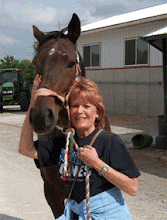Slaughter Alert Part Three
Under the Guise of Euthanasia
© Wild for Life Foundation
Part 1 of a 3 part series
Feb 15, 2010
By Katia Louise
Part 3 of 3: Under the Guise of Euthanasia
Pro slaughter lobby pushing to open horse slaughter plants in 23 states across the US
Article Highlights:
In a recent report by Animals’ Angels USA, where investigations of horse slaughter focused on conditions and treatment of horses at slaughter plants, auctions, feedlots and during transport investigations, it was found that “the instant a horse is designated a ‘kill horse’, handling and treatment change radically from that normally given horses.
• Auction employees use wooden sticks, striking horses with full range of motion and force
• auction workers hitting in face and jabbing in eyes
• transport driver whipping horses over the head, hips and legs
A 2008 report by the Canadian Horse Defense Coalition revealed unacceptable practices regarding the stunning and slaughtering of horses inside the plant. The CHDC report states, “They did not necessarily ensure accurate hitting of the horses with the captive bolt”; further that, “systemic neglect, cruel handling, poor slaughter practices, resulting in immense suffering.”
In 2004 the Government Accountability Office (GAO) found the most frequent violation noted by inspectors in slaughter houses was ineffective stunning, meaning "in many cases ..a conscious animal reached slaughter" in violation of the Humane Methods of Slaughter Act.
The USDA affirms that, “Humane stunning procedures are required by the Humane Slaughter Act of 1978, and multiple stuns of an animal are considered INHUMANE.”
According to the Act, animals should be stunned into unconsciousness prior to their slaughter to ensure a quick, relatively painless death.
"The captive bolt is not a proper instrument for the slaughter of equids, these animals regain consciousness 30 seconds after being struck, they are fully aware they are being vivisected." -Dr. Lester Friedlander, DVM & former Chief USDA Inspector
As reported by the USDA, ...FSIS observed deficiencies include: overcrowding of animals in holding pens resulting in animals not being able to get to the watering troughs; improper stunning of both normal and downer animals.
The USDA further reports that Employees in three of the five remaining plants used devices such as whips, a length of garden hose, or plastic tubing to drive the animals.
As documented by Animals’ Angels in their 2008 investigation of the Juarez, Mexico Horse Slaughter Plant, horses are killed with a “puntilla knife.(3) “Such a barbaric practice does not render the horse unconscious, it simply paralyzes the animal. The horse is still fully conscious at the start of the slaughter process during which the animal is hung by a hind leg, its throat slit and its body butchered.”(4) – Dr Nicholas Dodman BVMS, MRCVS, and Founding Member Veterinarians for Equine Welfare
Despite countless instances of documented cruelty ...law enforcement agencies continue to look the other way, fines are not enforced and America's dirty little secret goes on and on.
Proponents argue if horse slaughter plants were reopened in the US, that horses would be protected from cruelty by the Humane Slaughter Act which is enforced by the USDA FSIS inspectors; however findings indicate that inspectors have become paper pushers and don’t have access to the slaughter area on a regular basis. “We are the people who are charged by Congress with enforcing HSA, but most of our inspectors have little to no access to those areas of the plants where animals are being handled and slaughtered,” said Arthur Hughes, President of the National Joint Council of Food Inspection Locals.
Many policy makers are being mislead, and or bought out by special interests. Many of those who oppose a ban of horse slaughter have been misled to believe that there are allegedly too many so called “unwanted” and “excess” horses and/or that horse slaughter is purportedly humane.
Proponents are pushing for Americans “to accept and embrace the idea of using horse meat for human consumption”. Legislative action is mounting in 23 states encouraging foreign interests to invest in horse slaughter plants and there are aggressive lobbying efforts to reverse the court actions in Texas and Illinois to re-open horse slaughter plants.
Read Part Three in it's entirety HERE
Read part one of this report to get the facts about the UOH’s newest campaign effort; a nationwide so-called 'Do Not Slaughter' registry.
Read part two of this report to see how the humane argument as supported by the AVMA and the AAEP has been used to influence and mislead certain industry leaders and US policy makers.
Learn more:
Saving America’s Horses - A Nation Betrayed
Tuesday, February 16, 2010
Subscribe to:
Post Comments (Atom)






No comments:
Post a Comment